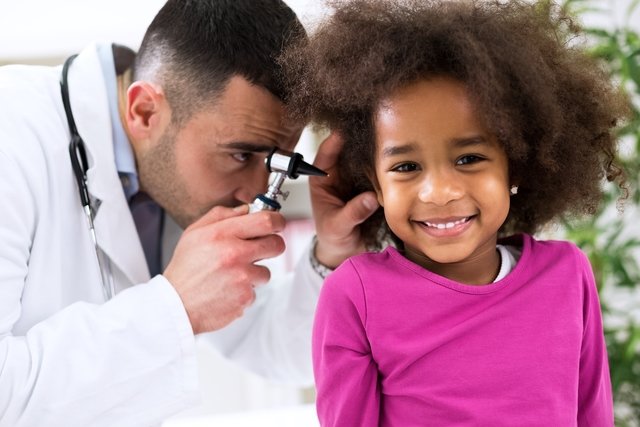Some ear infections medications, such as ibuprofen, paracetamol or hydrocortisone, can help reduce inflammation in the external ear canal or middle ear, relieving ear pain or discomfort.
Furthermore, in cases of bacterial infections, the otorhinolaryngologist may recommend antibiotics for otitis, such as polymyxin B or ciprofloxacin, in the form of drops to drip into the ear or tablets for oral use.
Read too: Otitis: what it is, symptoms, types, causes and treatment
Treatment with otitis medication should always be carried out with the recommendation of an otorhinolaryngologist, according to the type of otitis and its cause.

8 remedies for otitis
The main remedies for otitis are:
1. Paracetamol
Paracetamol is an analgesic and antipyretic that may be recommended by your doctor to relieve ear pain caused by otitis media or otitis externa.
This medicine can also reduce the fever that can arise in cases of ear infections, and can be used by adults, children, pregnant or breastfeeding women.
Paracetamol can be found in the form of tablets or syrup, for oral use, and should be used with the advice of an otorhinolaryngologist.
How to use: the recommended dose for adults or children over 12 years of age is 1 to 2 500 mg tablets, 3 to 4 times a day. The maximum dose per day is 8 paracetamol 500 mg tablets. See how to use paracetamol correctly.
2. Dipyrone
Dipyrone is another analgesic and antipyretic that can be recommended by an otorhinolaryngologist to relieve ear inflammation and symptoms of otitis externa or acute otitis media, such as ear pain or fever.
This medicine can be found in the form of drops, tablets or syrup, to be taken orally, and should not be used by pregnant women, babies under 3 months of age or weighing less than 5 kg and for people who have allergies. to dipyrone or other medicines for pain or fever.
How to use: The recommended dose for adults and adolescents over 15 years of age is 20 to 40 drops of dipyrone 500 mg/mL in a single dose. The daily dose should not exceed 40 drops, up to a maximum of 4 times a day. Find out how to take dipyrone.
3. Ibuprofen
Ibuprofen is a non-steroidal anti-inflammatory drug indicated for ear pain caused by otitis, as it reduces the production of inflammatory substances that cause inflammation and pain in the ear.
Read too: Earache: 12 main causes (and what to do)
This medicine can be found in the form of tablets, gelatin capsules, oral suspension or drops for oral use, and should only be used with the advice of an otorhinolaryngologist.
Ibuprofen should not be used by pregnant or breastfeeding women and by babies under 6 months of age, or by people with suspected or confirmed dengue fever, or those allergic to ibuprofen or other non-steroidal anti-inflammatory drugs.
How to use: the normally recommended dose for adults or children over 12 years of age is 1 to 2 200 mg tablets every 4 to 6 hours, or as directed by a doctor. The maximum daily dose should not exceed 6 tablets of 200 mg per day, in divided doses. Find out how to take ibuprofen.
4. Hydrocortisone
Hydrocortisone, associated with ciprofloxacin, is indicated for the treatment of bacterial otitis externa, as it contains a corticosteroid with powerful anti-inflammatory action and an antibiotic, which eliminates bacteria that are causing the infection.
This remedy is found in the form of drops to drip into the ear, under the commercial name Otociriax.
Hydrocortisone + ciprofloxacin should not be used by children under 1 year of age or by people with ear infections caused by fungi, tuberculosis or herpes, perforated eardrum or otitis media. During pregnancy or lactation, this medicine should only be used if indicated by your doctor.
How to use: the recommended dose for adults or children over 1 year of age is 3 drops in the affected ear, twice a day, for 7 days of treatment, as per medical advice.
5. Ciprofloxacin
Ciprofloxacin is an antibiotic indicated for the treatment of acute otitis media caused by bacteria, available in the form of tablets for oral use or drops to be applied to the ear.
Ciprofloxacin tablets should only be used by adults and are contraindicated for pregnant or breastfeeding women, or for people who are allergic to this medicine.
How to use: the normally recommended dose for adults is 1 tablet of 250 or 500 mg, twice a day, according to medical advice. See how to use ciprofloxacin correctly.
6. Polymyxin B and neomycin
Polymyxin B and neomycin are antibiotics in the form of ear drops to be dripped into the ear, indicated for the treatment of otitis externa caused by bacteria.
Read too: Otitis externa: what it is, symptoms, causes and treatment
This remedy can be found in association with hydrocortisone, under the trade name Otosporin, or in association with fluocinolone acetonide, under the name Otosylase.
How to use: in the case of Otosporin drops (polymyxin B, neomycin and hydrocortisone) the recommended dose for adults or children over 12 years of age is 3 drops in the affected ear, 3 to 4 times a day, for 7 to 10 days, as per medical advice .
The dose of Otosylase drops (polymyxin B, neomycin and fluocinolone acetonide) for adults is 3 or 4 drops in the affected ear, 2 to 4 times a day, according to medical advice.
7. Lidocaine
Lidocaine, associated with polymyxin B, has antibiotic and anesthetic action, which helps eliminate bacteria that cause otitis externa and relieve ear pain.
Read too: 5 simple tips to relieve ear pain
This remedy can be found under the trade name Lidosporin and is contraindicated in cases of perforation in the eardrum or allergies to the components of the formula.
How to use: The recommended dose for adults, children or infants is 3 to 4 drops of Lidosporin in the affected ear, 3 to 4 times a day, as advised by the otorhinolaryngologist. For children, this medicine should only be used under medical supervision.
8. Amoxicillin
Amoxicillin is an antibiotic that can be recommended by the otorhinolaryngologist in cases of otitis media or interna, and is available in the form of tablets or suspension for oral use.
Read too: Otitis media: what it is, symptoms, types, causes and treatment
Generally, this remedy is indicated when the ear pain does not go away within 72 hours with the use of analgesics or anti-inflammatories.
Amoxicillin should not be used by people who are allergic to penicillins or cephalosporins. During pregnancy or breastfeeding, this medicine should only be used if indicated by your doctor.
How to use: The normally recommended dose of amoxicillin for adults is 250 mg to 500 mg orally, 3 times a day, as per medical advice. Find out how to take amoxicillin.
Other oral antibiotics that may be recommended by your doctor are azithromycin or ceftriaxone, for example.
Remedy for childhood otitis
Remedies for childhood ear infections are mainly analgesics or anti-inflammatories, such as paracetamol or ibuprofen, to relieve ear pain, inflammation or fever.
Read too: Earache in a baby: symptoms and remedies
For children under 6 months of age, who have a fever above 39ºC, severe ear pain or have symptoms of otitis for 48 hours, treatment is normally done with the use of antibiotics, such as amoxicillin.
Medicines for childhood otitis should always be prescribed by a pediatrician or pediatric otorhinolaryngologist, after evaluating the child and the cause of the otitis.
Home remedy for otitis
A good home remedy for otitis is to place a bag of warm water on the affected ear, as the heat helps to increase circulation in the area, reducing ear pain.
This home remedy is a good way to complement the treatment recommended by the otorhinolaryngologist, and does not replace the use of medicines or other treatments recommended by the doctor.
Read too: 4 home remedies for otitis

Sign up for our newsletter and stay up to date with exclusive news
that can transform your routine!
Warning: Undefined array key "title" in /home/storelat/public_html/wp-content/plugins/link-whisper-premium/templates/frontend/related-posts.php on line 12
Warning: Undefined array key "title_tag" in /home/storelat/public_html/wp-content/plugins/link-whisper-premium/templates/frontend/related-posts.php on line 13



